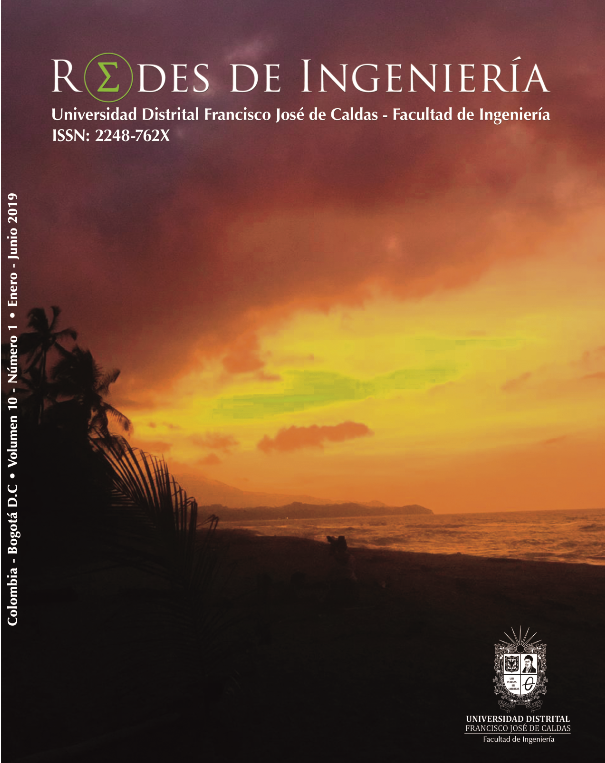DOI:
https://doi.org/10.14483/2248762X.14250Published:
2019-06-30Issue:
Vol. 10 No. 1 (2019): Enero - JunioSection:
Artículo CortoUso de la fibra sintética en el concreto estructural para edificaciones
Applications of reinforced concrete with synthetic fiber for buildings
Keywords:
synthetic fiber, reinforcement, structural elements, earthquake resistance (en).Keywords:
elementos estructurales, fibra sintética, reforzamiento, sismorresistencia (es).Downloads
Abstract (es)
En el 2016, se inicia la investigación buscando un concreto con mayor resistencia sin aumentar significativamente su costo. Al consultar varias fuentes se evidenció que el uso de las fibras en el mundo estaba aumentando. Ante los estudios realizados por otros investigadores, se plantea la hipótesis de que el uso de las fibras sintéticas en las estructuras verticales era demasiado limitado; así, se inició la consulta de fuentes acerca de las propiedades físicas y químicas de esta fibra. El inicio del uso a nivel mundial en materia de fibras sintéticas se da en Japón, lugar de varias empresas que fabrican y comercializan este material como refuerzo del concreto. La investigación llevó a la Universidad de Michigan, donde el director de investigaciones, el doctor Víctor Li, también avanzaba en el estudio del comportamiento y usos del concreto reforzado con fibra sintética, lo cual brindó la motivación para creer que el camino escogido era el correcto.
Abstract (en)
In 2016 the research begins, looking for a material with the premise of increasing the strength of the concrete without this being directly proportional to the relationship with the cost. After consulting several sources, it was evidenced that the use of fibers in the world was increasing. Before the studies carried out by other researchers, it was hypothesized that the use of synthetic fibers in vertical structures was too limited. The consultation of sources about the physical chemical properties of these fibers was initiated, thus posing a possible solution to the problem of improving resistance versus reasonable cost. The beginning of the use worldwide in the matter of synthetic fibers goes back to Japan, place of several companies that manufacture and commercialize this material as reinforcement of the concrete. The research transported us to more than 10,000 kilometers, taking us to the University of Michigan, where the director of research Dr. Víctor Li, also advanced in the study of the behavior and uses of synthetic fiber reinforced concrete, several emails and conversations with the research center, gave the motivation to believe that the chosen path was the right one.
References
García, “360 Grados en Concreto”. [En línea]. Disponible en: http://blog.360gradosenconcreto.com/concretos-de-alto-desempeno-en-edificios/
J. Won and S. Lee, “Flexural behavior of precast reinforced concrete composite members reinforced with structural nano-synthetic and steel fibers”, Composite Structures, n.º 118, pp. 571-579, 2014. https://doi.org/10.1016/j.compstruct.2014.07.042
M. G. Alberti, A. Enfedaque y J. C. Gálvez, “Comparison between polyolefin fibre reinforced vibrated conventional concrete and self-compacting concrete”. Construction and Building Materials, n.º 85, pp. 182-194, 2014. https://doi.org/10.1016/j.conbuildmat.2015.03.007
A. Zia and M. Ali, “Behavior of fiber reinforced concrete for controlling the rate of cracking in canal-lining”, Construction and Building Materials, n.º 155, pp. 726-739, 2017. https://doi.org/10.1016/j.conbuildmat.2017.08.078
M. A. Rasheed and S. S. Prakash, “Mechanical behavior of sustainable hybrid-synthetic fiber reinforced cellular light weight concrete for structural applications of masonry”, Construction and Building Materials, n.º 98, pp. 631-640, 2015. https://doi.org/10.1016/j.conbuildmat.2015.08.137
A. M. Alani and D. Beckett, “Mechanical properties of a large scale synthetic fibre reinforced concrete ground slab”. Construction and Building Materials, n.º 41, pp. 335-344, 2012. https://doi.org/10.1016/j.conbuildmat.2012.11.043
J. D. Tabares, “El concreto: tan flexible como resistente”. [En línea]. Disponible en: https://www.360enconcreto.com/blog/detalle/categoryid/178/categoryname/concreto/el-concreto-tan-flexible-como-resistente
Argos, “Portal Lógico de Colombia”. [En línea]. Disponible en: http://plc.mintransporte.gov.co/es/noticias/concreto-avanzado-solucion-para-estructuras-en-zonas-costeras
S. Franco, “360 Grados”. [En línea]. Disponible en: http://blog.360gradosenconcreto.com/concretos-de-alto-desempeno-en-edificios/
P. Dahl, «"Plastic shrinkage and cracking tendency of mortar and concrete containing fiber mesh", FCB Cement and Concrete Institute, Trondheim, Norway,,» 1985.
A. 211.1, « Standard Practice for Selecting Proportions for Normal, Heavyweight and Mass Concrete. Reported by ACI Committee 211,» 1991.
U. Commons, 2010. [En línea]. Disponible en: http://upcommons.upc.edu/bitstream/handle/2099.1/3324/55872-8.pdf
Arqhys, “Resistencia del concreto al corte”. [En línea]. Disponible en: http://www.arqhys.com/contenidos/resistencia-concreto-corte.html
Instituto Nacional de Vias, “Resistencia a la fexión del concreto. Método de la viga simple cargada en el punto central. [En línea]. Disponible en: ftp://ftp.unicauca.edu.co/Facultades/FIC/IngCivil/Especificaciones_Normas_INV-07/Normas/Norma%20INV%20E-415-07.pdf. https://doi.org/10.7203/normas.3.4678
J. Maracano, “360 Grados en Concreto”. [En línea]. Disponible en: http://blog.360gradosenconcreto.com/el-concreto-tan-flexible-como-resistente/.
C. J. Mendoza, C. Aire y P. Dávila, “Influencia de las fibras de polipropileno en las propiedades del concreto en estados plástico y endurecido”, Concreto y Cemento, n.° 2, vol. 2, 2011.
A. Alhozaimy, P. Soroushian and F. Mirza, “Mechanical properties of polypropylene fiber reinforced concrete and the effects of pozzolanic materials”, Cement and Concrete Composites, pp. 85-92, 1992. https://doi.org/10.1016/0958-9465(95)00003-8
How to Cite
APA
ACM
ACS
ABNT
Chicago
Harvard
IEEE
MLA
Turabian
Vancouver
Download Citation
License
Reconocimiento – NoComercial – CompartirIgual (by-nc-sa): No se permite el uso comercial de la obra original, las obras derivadas deben circular con las mismas condiciones de esta licencia realizando la correcta atribución al autor.
Esta obra está bajo una licencia de Creative Commons Reconocimiento-NoComercial-CompartirIgual 4.0 Internacional













